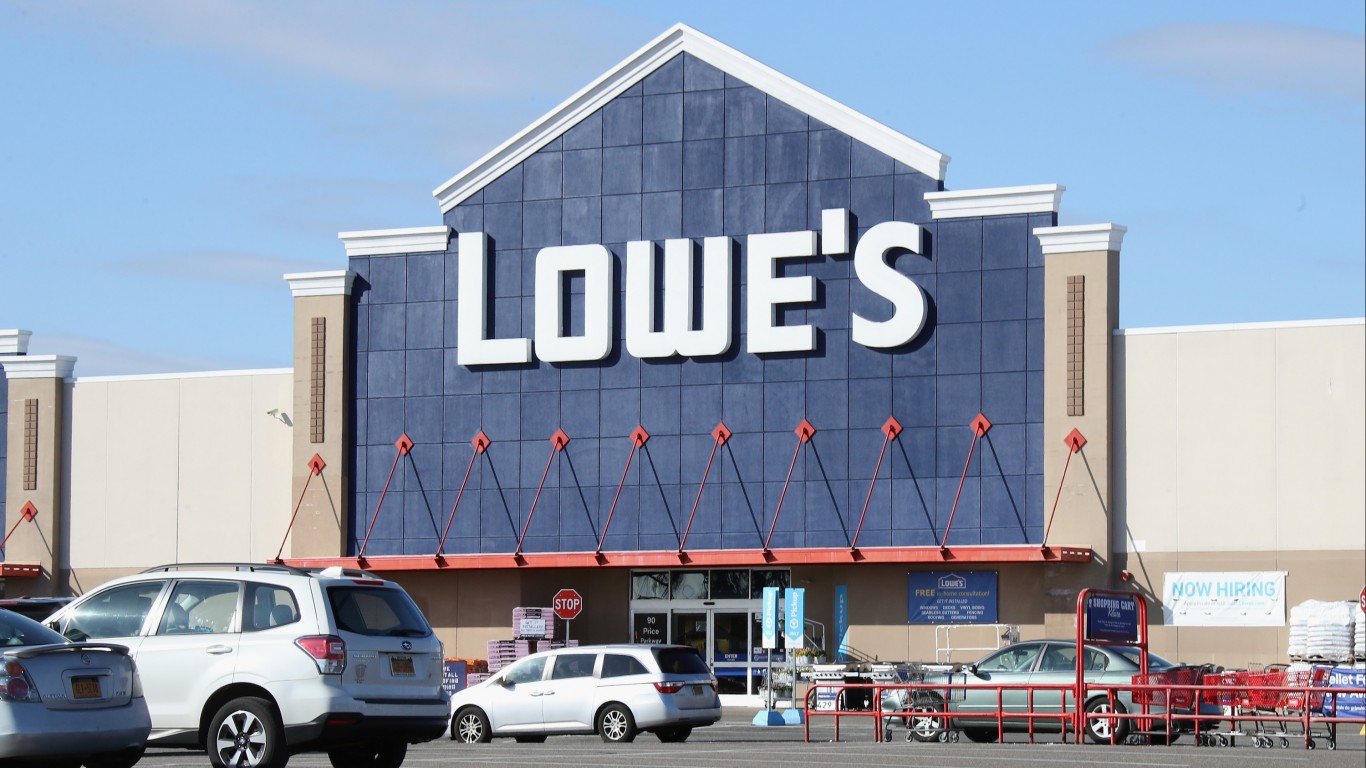
24/7 Wall Street Insights
- Inflation is still keeping prices of everyday goods high, with no reductions in sight.
- In order to make ends meet, a majority of American families are being forced to either cut expenses or augment the household budget.
- Dividend stocks provide a number of positive attributes that are attractive to investors of all levels of risk tolerance and liquid principal.
- For a free report on two high dividend stocks, click here.
As 2024 enters mid-year, June signals the onset of summer and inflated prices have still not come down. For example, a dozen eggs in 2020 that were $2.00 are still over $3.00 at present, according to the Bureau of Labor Statistics. A 2020 gallon of gasoline was $1.99; that same gallon of gasoline costs $3.58 as of May, 2024.
With household budgets already stretched to the limit, and buying power continuing to erode, American families are faced with having to either cut back on all non-essentials or boost income. Income boosting options can be either active, such as with a second job or a side gig, or passive. Time bandwidth and family obligations can make the active option untenable. For passive options, Rich Dad/Poor Dad author Robert Kiyosaki has lauded the principles of investing to result in passive income from real estate, capital markets, businesses, and other assets. Dividend stocks are a particularly attractive asset class to generate passive income for a number of reasons.
Why Dividend Stocks?

- Liquidity: if investment funds are suddenly required for an emergency, stocks can easily be sold. With T+1 settlement starting after Memorial Day, funds can be available the day after a sale.
- Diversification: Dividend stocks account for over 30% of the S&P 500 public companies. If market events determine that one stock needs to be sold, finding a replacement with an equivalent yield for a portfolio is a relatively easy task.
- Principal Safety: Stocks that pay dividends, on average, tend to have less trading volatility than small cap high flying stocks. The high flyers can’t afford to pay dividends due to their high cash burn rate.
- Legal Liability Mitigation: Unlike owning real estate, which can entail legal liability if a personal injury is incurred, owning stock shares confers no such responsibility to a shareholder.
- Low Admission Cost: Compared with the thousands of dollars or more that real estate or other platforms can cost to make an investment, stocks can be had much less expensively, even more so now that fractional shares are now currently available.
- Capital Appreciation Capacity: depending on the stock and its future business prospects, some dividend stocks also may have considerable upside potential on the capital appreciation side. This differs from bonds, which only offer interest and return of principal. Any capital appreciation component with bonds are solely in circumstances where interest rates are lower than at acquisition, and the bond is sold prior to maturity.
24/7 Wall Street has published numerous articles about dividend stocks, based on a range of investment risk tolerance and principal amounts. High dividend stocks, monthly dividend stocks, and dividend stocks in specific industrial sectors are all listed in 24/7 Wall Street’s extensive database. With June fast approaching, here are five (5) dividend stocks of varying yields and industries that just might be some of the best choices towards passive income for the rest of 2024, based on current market prices at the time of this writing. For comparison’s sake, annual dividend amounts will be calculated on a hypothetical $10,000 investment each.
Kimbell Royalty Partners LP

Stock #1: Kimbell Royalty Partners LP (NYSE: KRP)
Yield: 10.87%
Shares for $10,000:~597.4
Annual Income:~$1,087.00
The oil and gas industry has been traditionally separated into two sub-sectors: Exploration and Production (E&P), which focused on surveying and drilling, and Midstream (storage, transportation, and distribution). However, Darin Zanovich, CEO of Mesa Minerals III, recently disclosed to Oil & Gas Investor that a third asset class has now emerged: Minerals and Royalties.
While oil and gas properties usually gather premium attention for their energy reserves and extraction potential, the lucrative mineral by-product rights and their corresponding royalty interests from those same lands can warrant standalone businesses on their own merits. Fort Worth, TX headquartered Kimbell Royalty Partners LP is one such enterprise.
Kimbell Royalty Partners’ income is derived as a result of direct mineral rights ownership from 17 million gross acres of oil and gas land supporting 129,000 gross wells. It presently holds mineral rights positions in proximity to 97% of all onshore rigs in the continental United States.
As its revenues come solely from holding royalty rights, Kimbell Royalty Partners’ business model is not unlike that of songwriters. Songwriters receive publishing royalties every time his or her songs are played on the radio, streamed on Spotify, or are sold in a download or a compact disc. Consequently, Kimbell Royalty Partners incurs zero operating costs or capital expenditures, so profit margins are very fat. Since it is neither a traditional Master Limited Partnership, nor a Royalty Trust, Kimbell investors benefit from tax-advantaged distributions via 1099-DIV, as opposed to K-1.
Analysts from RBC have recently noted that oil and gas mineral and royalty stocks have grown over 130% since the end of the pandemic. In comparing mineral companies vs. E&P companies, RBC cited the following advantages of the mineral companies, such as:
- Exploration and Production companies may incur undefined costs, especially if faced with dry or unproductive sites. Mineral companies face no such liabilities.
- Exploration and Production companies have to negotiate a separate lease for underground mineral interests, which is subject to expiration. Mineral companies make a one-time payment for underground mineral interests that are held in perpetuity.
- Mineral companies are free to agnostically negotiate and lease mineral royalty rights from any energy producing lands, regardless of whether Exxon Mobil, Chevron, or whatever oil company may have the drilling and production rights.
Whirlpool Corporation

Stock #2 : Whirlpool Corporation (NYSE: WHR)
Yield: 7.72%
Shares for $10,000:~181.6
Annual Dividend Income:~$772.00
In the post-World War II era, the American lifestyle became the envy of the world. The US emerged relatively unscathed by battles that were concentrated in Europe and Asia. Thus, the US manufacturing behemoth that had been dedicated to building tanks, battleships and fighter jets shifted towards luxury cars and large home appliances designed for household convenience, like laundry machines and refrigerators.
Founded 113 years ago in 1911, Benton Harbor, MI headquartered Whirlpool Corporation has maintained its status at the forefront of the American-made appliance sector for the better part of the 20th century through to the present day. Under brand names such as: Whirlpool, Maytag, KitchenAid, Amana, Consul, Hotpoint, and fifteen others that are marketed around the globe, Whirlpool’s refrigerators, laundry machines, ovens, stovetop ranges, freezers, and water filters continue to provide millions of people much needed labor-saving relief.
In addition to large appliances, Whirlpool also markets air conditioners, air purifiers, humidifiers, and smaller domestic household kitchen centered machines, such as mixers, blenders, coffee makers, microwave ovens, air fryers and many other food preparation, cooking and baking appliances.
Over the last 13 years, Whirlpool has increased its dividend payout 9 times. With a nod towards protection of Whirlpool’s dividends, management has been taking a savvy, proactive approach towards dealing with market conditions in order to protect its shareholders. For example, due to inflation-fueled, consistently high prevailing interest rates, the company announced in late February 2024 that it had begun reducing its debt-to-earnings ratio. Whirlpool’s 3.6% ratio is on track to reduce down to a 2.0% target by 2026. . It also announced a simplification overhaul of its infrastructure in order to cut costs ($800 million in 2023, with a further $300 million to $400 million planned for 2024).
Additionally, Whirlpool recently closed a deal to combine its European major domestic appliance (MDA) business with an Arcelik business (Beko Europe, a new company, in which Whirlpool owns a 25% stake). This is anticipated to rid the company of a low-margin and cash-guzzling business. Whirlpool’s overall margin and cash flow generation should improve as a result.
For the past 14 consecutive years, Whirlpool has been listed in the Fortune “World’s Most Admired Companies” list, which ranks companies by product quality, service efficiency and personality, and other criteria.
Enterprise Products Partners LP

Stock # 3 : Enterprise Products Partners LP (NYSE: EPD)
Yield: 7.21%
Shares for $10,000: ~ 349
Annual Dividend Income: ~$721.00
The midstream energy industry is the infrastructure that makes crude oil and natural gas into a valuable energy commodity. By providing transportation services via pipeline, ocean tanker, rail and trucks, in addition to storage facilities, midstream companies are essential to the supply chain for getting crude and natural gas to refineries or other processing locations. Afterwards, they then move refined Natural Gas Liquids (NGL), gasoline, kerosine, propane, or other refined petroleum products, to warehouses, and subsequently retail distribution, or to export terminals. For tax purposes, they are often organized as limited partnerships.
Houston, TX headquartered Enterprise Products Partners LP operates in CO, NM, LA, MS, WY, and TX. Founded in 1968, Enterprise has a 7% compound annual growth rate, which will likely get a boost in the future. The company has close to $7 billion worth of expansion projects currently under construction, so the company’s growth prospects are very bullish. These include a new fractionator scheduled to launch operations in 2025, three new NGL plants in 2025-2026, and a new propane and ethane export terminal in 2026. Since the stock trades at roughly 10-11 times earnings, institutional investors on the prowl for value investments with strong and stable dividends will likely take notice.
Given that the yield goes down as a stock price goes up, June might represent a shrinking window of opportunity to take advantage of an annual yield north of 7%. On the other hand, Enterprise is one of the largest publicly traded Master Limited Partnerships in the US and has a 25 year track record of dividend increases, so dividend size may also have upside prospects for investors of record.
Verizon Communications

Stock #4 : Verizon Communications (NYSE: VZ)
Yield: 6.63%
Shares for $10,000:~253.2
Annual Dividend Income: ~$663.00
Verizon Communications is the largest US wireless carrier, based on its extensive national network. In light of the current antitrust obsession demonstrated by the FTC, it’s interesting to note that Verizon was formed in 2000 from the former “Baby Bell” companies, Bell Atlantic and Nynex, along with GTE, which were originally all part of AT&T (NYSE: T), or Ma Bell. They were all split up into 7 separate companies in 1984 by the DOJ in an antitrust case.
Verizon has the largest domestic US wireless network. Management acknowledges that with over half of its revenues derived from that sector, it has more vulnerabilities if there are issues with satellite signals or other wireless related service problems than its competitors. As a result, Verizon is in the process of further developing its 5G and AI technologies.
Verizon’s FIOS optic fiber system is the core of its 5G network and it proudly advertises that it has been the past decade’s recipient of the greatest number of consumer awards for customer satisfaction and internet speeds. Although not as widespread as AT&T’s 5G system, it is unquestionably faster, according to all head-to-head trials conducted by analysts. FIOS’ superior speed results in lower latency, a feature that has become a driving force behind the growth of the 5G IoT (Internet of Things) market. Verizon recently announced a deal with KDDI of Japan to provide 4G/5G IoT connectivity for an electric vehicle from Sony Honda Mobility. Sony Honda has christened it the AFEELA line of EVs, and they are expected to launch by 2025 with a U.S. debut by 2026.
On the AI front, Verizon is deploying human-assisted GenAI applications to streamline processes, better equip Verizon employees, and to enhance the customer service experience. The AI tools supply human representatives with guidance, best solutions suggestions for customer problems, and a subsequently higher rate of customer satisfaction reports. Verizon states that its GenAI platform has improved accurate customer inquiry problem solving to 95%.
The GenAI’s key innovations immediately deliver personal customer information, which can then be routed to the customer service rep best suited for the problem at hand. For example, an international service query would be routed to the rep most experienced in that sector. The GenAI then suggests the menu of solutions with the most comprehensive one suggested.
Realty Income Corporation

Stock #5 : Realty Income Corporation (NYSE: O)
Yield: 5.61%
Shares for $10,000: ~181.55
Annual Dividend Income: ~$561.00
Real Estate Investment Trusts (REITs) are entities that register with the SEC and, for tax purposes, are required to remit 90% of profits to shareholders. A number of REITs pay a dividend monthly, as opposed to quarterly. San Diego-based Realty Income Corporation not only has unwaveringly paid out monthly dividends to its shareholders, but has notched 125 consecutive quarterly dividend increases since its 1994 public listing debut.
Founded in 1969, Realty Income is an S&P 500 company that is the largest net lease (tenant pays most to all operating costs and insurance) publicly traded REIT. Its massive real estate portfolio owns a total of 15,400 properties across all 50 states, as well as in the UK, Ireland, Germany, Italy, France, Spain, and Portugal. The properties are in the retail, agricultural, and industrial sectors. Among Realty Income’s noteworthy tenants are: CVS Pharmacy, Chipotle, Lowe’s, Treasury Wine Estates, 7-Eleven, Sainsbury’s and others.
Due to its size, Realty Income has the financial clout to raise capital at low cost, which allows it to aggressively bid on properties and still make a profit. It also can bid for larger deals on its own, without having to syndicate them. Its most recent acquisition was Spirit Realty Capital, and the company also closed two gaming industry deals and formed a joint-venture with Digital Realty Trust to construct and lease data centers.
Like any other stock portfolio, it is wise to submit it to regular monitoring, so prompt action can be taken if there is a need to sell a stock or substitute it for another one, especially if dividends are involved, and the investor is reliant on the passive income generated accordingly. With June creeping up quickly, buying the dividend stocks needed to provide the passive income amount targeted for a household budget will be one less concern to worry about so an enjoyable summer can follow.
| Name: | Yield: | Annual Dividend Income from $10,000 investment: |
| Kimbell Royalty Partners LP (NYSE: KRP) | 10.87% | ~$1,087.00 |
| Whirlpool Corporation (NYSE: WHR) | 7.72% | ~$772.00 |
| Enterprise Products Partners LP (NYSE: EPD) | 7.21% | ~$721.00 |
| Verizon Communications (NYSE:VZ) | 6.63% | ~$663.00 |
| Realty Income Corporation (NYSE: O) | 5.61% | ~$561.00 |
Are You Still Paying With a Debit Card?
The average American spends $17,274 on debit cards a year, and it’s a HUGE mistake. First, debit cards don’t have the same fraud protections as credit cards. Once your money is gone, it’s gone. But more importantly you can actually get something back from this spending every time you swipe.
Issuers are handing out wild bonuses right now. With some you can earn up to 5% back on every purchase. That’s like getting a 5% discount on everything you buy!
Our top pick is kind of hard to imagine. Not only does it pay up to 5% back, it also includes a $200 cash back reward in the first six months, a 0% intro APR, and…. $0 annual fee. It’s quite literally free money for any one that uses a card regularly. Click here to learn more!
Flywheel Publishing has partnered with CardRatings to provide coverage of credit card products. Flywheel Publishing and CardRatings may receive a commission from card issuers.
Thank you for reading! Have some feedback for us?
Contact the 24/7 Wall St. editorial team.





